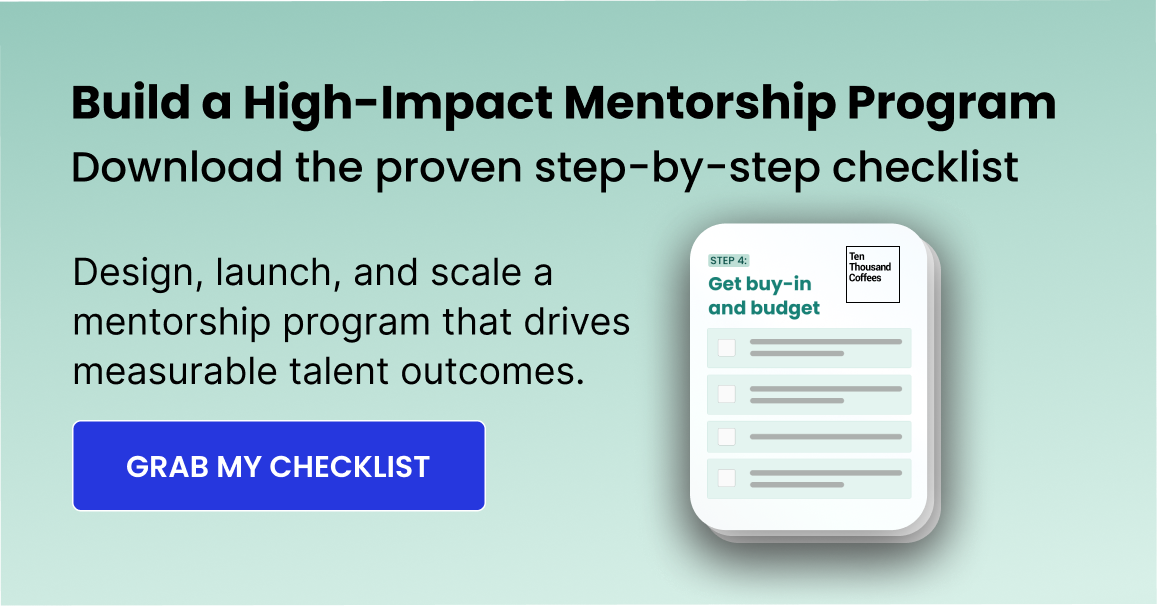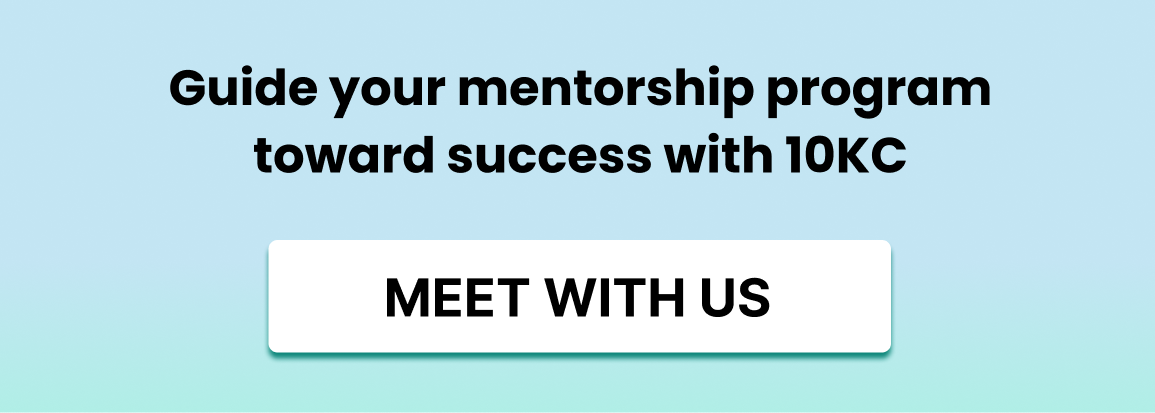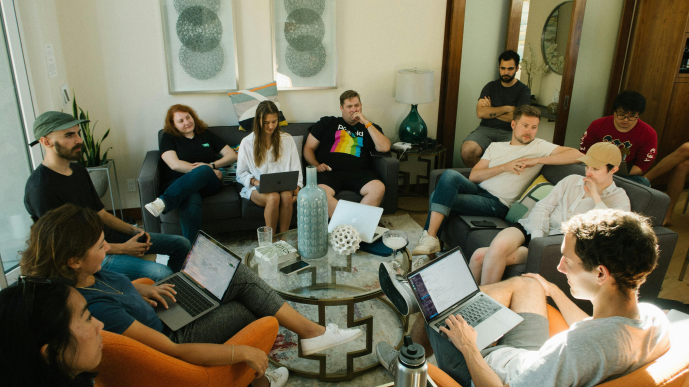The success of your mentoring program can rest on several factors, from overall program structure to the types of mentorship experiences you provide. At the top of that list? Your mentor-mentee relationships.
Mentorship is, at its core, a social learning experience. It’s about people connecting, growing, and learning from one another. And just like any talent program, it takes the right foundation to thrive.
To deliver a high-impact mentoring experience, you need to set participants up for success. That means equipping them with the best tools and frameworks to build strong connections, develop critical skills, and achieve specific goals.
Stick with us as we explore some mentoring guidelines and strategies that can help you foster effective mentor-mentee relationships that move the needle on the metrics you care about.
Making the right mentor-mentee matches
Strategic mentor-mentee pairings aren’t a silver bullet, but they’re essential for setting relationships (and your mentorship program overall) up for success. It’s not enough to simply match any two employees and hope for the best. Effective mentorship starts with thoughtful, intentional pairing decisions.
The best mentor-mentee matches:
- Consider criteria that ladder up to larger talent goals.
- Integrate individual mentor/mentee experiences, preferences, and goals.
- Go beyond employee seniority level.
- Factor in time zones and geographic locations.
📌 READ MORE: Effective Mentorship Programs Start with Strong Goals. Here's How.
For example:
- If your goal is internal talent mobility, consider matching employees with leaders or teams actively hiring for lateral or upward roles.
- If you’re aiming to break down silos and strengthen collaboration globally, match employees from different departments or functions across time zones.
- If skills development is the priority, pair participants based on the complementary skills they want to build or can offer.
Where program admins often get stuck is trying to create these types of dynamic matches manually. When you’re managing hundreds or thousands of participants, it’s nearly impossible to account for all the variables that make a match successful. It’s hard enough even with just a few dozen employees. .
That’s where smart-matching technology comes in. By leveraging algorithms designed to align with your unique program goals and employee criteria, you can scale strategic matching without the guesswork. Simply input your custom matching parameters, and let the technology optimize pairings that drive meaningful outcomes.
📌 READ MORE: How to Strategically Match Mentors and Mentees
Setting foundational mentoring guidelines
When someone joins a new company, they’re typically given onboarding or training to create clarity and alignment from the get-go. The underlying logic is simple: people need early guidance and support to set them up for success and drive toward intended outcomes.
You should look at mentorship programs in the same manner. People often assume mentoring (or being mentored) is something that comes naturally, but that’s rarely the case. Even if employees have been a part of a mentoring program in the past, it doesn’t necessarily mean they have a clear understanding of the expectations, goals, or logistics of your unique program.
Laying the groundwork gives mentors and mentees the solid footing and confidence to make the most of their experience. Here are two key milestones for ramping up mentoring relationships effectively in the early stages of your mentorship program.
1. Orientation on what to expect from mentoring relationships
Before your mentoring program officially launches, set the stage with guidelines around:
- Participant expectations: Help employees understand what to expect and their role as a mentor or mentee.
- Fostering successful relationships: Building rapport with a brand-new person can be tough. Give participants some best practices for creating authentic and meaningful mentorship relationships.
- Timelines: Give participants a clear idea of the required commitments, including the frequency and length of meetings and overall program timelines.
- Values and outcomes: What can employees expect to gain from this experience?
Once everyone has a clear foundation, you’re ready to kick off your mentor-mentee relationships with intention. Still, a great mentor-mentee match is just the starting point. Participants need more than an introduction to thrive. They need guidance to turn introductions into impactful relationships, rather than leaving them to their own devices.
“Mentoring is something that I think every successful person and team knows needs to happen. And what this will do is just accelerate the outcomes and help you do that in bigger, faster, better ways. [...] It's just going to guide you to get to those outcomes in a lot more effective ways versus expecting that all of you are the PhDs, authors, and experts on how to make this all happen.” - Dave Wilkin, Cofounder, 10KC
2. Individual mentorship goals and priorities
Your mentorship program should already be grounded in strategic goals. Now it’s time to bring those goals to life, one relationship at a time. The first conversation between mentor and mentee should often focus on setting personal milestones within the context of the program, turning big-picture objectives into tangible, individualized growth.
For example:
- If the overall program goal is to increase employee mobility, a mentee’s personal goal might be to identify one or two areas of the business they would be interested in pursuing in their next role.
- If the focus is on skills development, they might discuss their areas of weakness or key competencies they’d like to build.
Early goal setting helps align expectations, spark momentum, and ensure both parties are working toward something concrete from the start.

Discussion guides for mentor-mentee meetings
One of the simplest ways to set participants up for success is by equipping them with the right tools. Conversation guides, suggested questions, and light-touch structure can help mentors and mentees ease into meaningful dialogue, build trust, and sidestep early missteps that often stall momentum.
To ensure consistent, high-quality conversations that align with your program’s goals, it’s important to provide discussion guides for ongoing mentor-mentee sessions. These guides act as helpful prompts, anchoring conversations around key themes that support learning, development, and progress.
While every mentoring relationship will take its own shape, discussion guides offer a structured starting point—without being overly prescriptive. The goal isn’t to script every conversation, but to give participants a framework that builds confidence, sparks meaningful dialogue, and keeps them moving forward.
Especially in the early stages, a well-designed guide can help reduce awkward silences, encourage deeper reflection, and keep both parties engaged and aligned.
“People will take it in their own direction, and that's part of the beauty of how it gets personalized. People make it relevant to them, but you want to give them enough of a starting point that there's common language. They're anchoring back on organizational resources, common language, and things that your HR and business leaders would want people to understand. It becomes a way to reinforce those topics." - Christine Silva, Talent Advisor, former leader at RBC, Catalyst, Shopify
Of course, discussion guides will look different depending on the talent group and knowledge you’re hoping for participants to share. You might even include pre-conversation resources and educational materials. It’s a great place to infuse expert-backed resources directly into the conversations and guide participants toward the skills you want to hone and develop.
How to keep the mentor-mentee relationship on track
One of the biggest value-adds of mentoring is that it’s driven by relationships. Unlike more traditional training programs, it gives participants the flexibility to lean into the conversations and experiences that best support them
But that doesn’t mean mentoring relationships shouldn’t still be focused and stay on track. Even beyond discussion guides, there are a few ways program managers can help keep mentor-mentee relationships on track—and ensure you’re delivering on your goals throughout the program.
- Provide clarity on mentor/mentee responsibilities: Who is responsible for booking the meetings? What requirements are there for availability?
- Create meeting reminders: Give participants a nudge so no session is missed. Including topics and agendas, and pre-meeting resources can help keep participants engaged between sessions and stay excited for the next experience.
- Follow-up after meetings: Provide opportunities for participants to provide feedback on their experiences, so you can iterate as needed and intervene if things aren’t progressing as expected.
With many employees facing all-too-busy work weeks, mentorship needs to fall seamlessly into your team’s workflows so they’ll stay engaged. This means using tools that streamline mentorship communication and scheduling.
How to know if mentoring relationships are working
While individual relationships might feel fulfilling, if they fail to drive the outcomes that matter, you end up with a mentoring program that’s nothing more than a feel-good initiative. To truly assess effectiveness, you need visibility into both the micro and macro levels of your program:
Relationship-level indicators
At the individual level, track metrics like:
- Participant engagement: Are mentors and mentees meeting regularly?
- Session status updates: Is progress being made across key milestones?
- Qualitative feedback: What themes are emerging in their discussions?
Consistent engagement, positive sentiment, and alignment to goals are strong signs of a healthy mentoring relationship. On the flip side, drop-off in activity or feedback suggesting lack of clarity or direction can signal that a match may need additional support.
Program-level impact
Beyond individual relationships, zoom out to assess whether the program is moving the needle on your core talent metrics. This means evaluating both:
- Leading indicators: Participation rates, feedback quality, and goal alignment that suggest early traction.
- Lagging indicators: Outcomes such as increased retention, improved internal mobility, enhanced employee engagement, or skill development that prove long-term impact.
When both layers are working together—strong individual relationships paired with measurable talent outcomes—you’re no longer just “running a mentoring program.” You’re activating a powerful engine for learning and growth across your organization.
“Activity metrics—like are people meeting— are absolutely necessary, but not sufficient. So how do we think about what other outcomes we can drive? It goes back to what metrics your leaders care about. Your stakeholders and their metrics. I've really seen the most success when my programs are a way to achieve existing stated metrics, where I'm an activation point for something that has already been decided is an organizational priority.”- Christine Silva, Talent Advisor, former leader at RBC, Catalyst, Shopify
📌 READ MORE: How to Measure the Success of Your Corporate Mentorship Program
Fuel successful mentoring relationships with 10KC
The right tools can be a powerful partner in structuring successful mentorship relationships. 10KC’s mentorship software is built to help organizations foster high-impact mentoring relationships that drive performance.
Over 200 organizations trust 10KC to fuel successful mentoring relationships through:
- Expert-backed discussion guides that keep conversations focused and foster authentic mentoring relationships.
- Personalized mentoring pathways tailored to the learning and development needs of various employee groups.
- A smart-matching algorithm that creates strategic mentor-mentee matches at scale that are set up for success from day one.
- Real-time reporting and analytics so you can showcase the impact of every mentoring experience.

Mentoring guidelines FAQs
What's the role of a mentor?
The role of a mentor is to guide and support their mentee. This can include areas of both personal and professional development, depending on the goals of the mentorship relationship. A mentor might provide hands-on training, advice, or feedback based on their own experiences to help their mentee reach their skills development and knowledge goals.
What's the role of a mentee?
The role of a mentee is to receive guidance and support from their mentor. Their responsibilities include identifying their goals and effectively engaging with their mentor and program experiences, so they can make the most of the opportunities for growth and development.
How long should mentoring relationships last?
Mentoring relationships often last anywhere from four to six months. But the ideal length can depend on your organizational and mentorship goals.









.png)